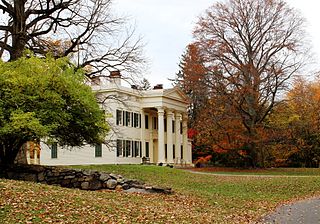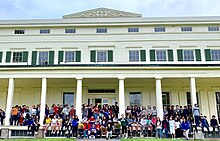
Westchester County is a county located in the southeastern portion of the U.S. state of New York, bordering the Long Island Sound to its east and the Hudson River on its west. The county is the seventh most populous county in the State of New York and the most populous north of New York City. According to the 2020 United States Census, the county had a population of 1,004,456, its highest decennial count ever and an increase of 55,344 (5.8%) from the 949,113 counted in 2010. Westchester covers an area of 450 square miles (1,200 km2), consisting of six cities, 19 towns, and 23 villages. Established in 1683, Westchester was named after the city of Chester, England. The county seat is the city of White Plains, while the most populous municipality in the county is the city of Yonkers, with 211,569 residents per the 2020 census. The county is part of the Hudson Valley region of the state.

Sleepy Hollow is a village in the town of Mount Pleasant in Westchester County, New York, United States.

Rye is a coastal city in Westchester County, New York, United States, located near New York City and within the New York City metropolitan area. It is separate from the Town of Rye, which has more land area than the city. The City of Rye, formerly the Village of Rye, was part of the Town until it received its charter as a city in 1942, making it the youngest city in the State of New York. Its population density for its 5.85 square miles of land is roughly 2,729.76/sq mi.

Philipsburg Manor House is a historic house in the Upper Mills section of the former sprawling Colonial-era estate known as Philipsburg Manor. Together with a water mill and trading site the house is operated as a non-profit museum by Historic Hudson Valley. It is located on US 9 in the village of Sleepy Hollow, New York.

Saint Paul's Church National Historic Site is a church and National Historic Site in Mount Vernon, New York, just north of the New York City borough of the Bronx. Established in 1765, Saint Paul's Church is one of New York's oldest parishes and was used as a military hospital after the American Revolutionary War Battle of Pell's Point in 1776. The 5-acre (20,000 m2) cemetery surrounding the church contains an estimated 9,000 burials dating from 1704. The church and cemetery were designated as a United States National Historic Site in 1978 to protect them from increasing industrialization of the surrounding area.

The Old Dutch Church of Sleepy Hollow (Dutch: Oude Nederlandse Kerk van Sleepy Hollow), listed on the National Register of Historic Places as Dutch Reformed Church (Sleepy Hollow), is a 17th-century stone church located on Albany Post Road (U.S. Route 9) in Sleepy Hollow, New York, United States. It and its three-acre (1.2 ha) churchyard feature prominently in Washington Irving's 1820 short story "The Legend of Sleepy Hollow". The churchyard is often confused with the contiguous but separate Sleepy Hollow Cemetery.

Frederick Philipse, first Lord of the Manor of Philipseborough and patriarch of the Philipse family, was a Dutch immigrant to North America of Bohemian heritage. A merchant, he arrived in America as early as 1653. In 1662, he married Margaret Hardenbrook de Vries, a wealthy and driven widow. Together, and variously in league with slavers, pirates, and other undesirables alongside the prominent and respectable, the couple amassed a fortune.

The John Jay Homestead State Historic Site is located at 400 Jay Street in Katonah, New York. The site preserves the 1787 home of Founding Father and statesman John Jay (1745–1829), one of the three authors of The Federalist Papers and the first Chief Justice of the United States. The property was designated a National Historic Landmark in 1981 for its association with Jay. The house is open year-round for tours.

The Boston Post Road Historic District is a 286-acre (116 ha) National Historic Landmark District in Rye, New York, and is composed of five distinct and adjacent properties. Within this landmarked area are three architecturally significant, pre-Civil War mansions and their grounds; a 10,000-year-old Indigenous peoples site and viewshed; a private cemetery, and a nature preserve. It is one of only 11 National Historic Landmark Districts in New York State and the only National Historic Landmark District in Westchester County. It touches on the south side of the nation's oldest road, the Boston Post Road, which extends through Rye. A sandstone Westchester Turnpike marker "24", inspired by Benjamin Franklin's original mile marker system, is set into a wall that denotes the perimeter of three of the contributing properties. The district reaches to Milton Harbor of Long Island Sound. Two of the properties included in the National Park Service designation are anchored by Greek Revival buildings; the third property is dominated by a Gothic Revival structure that was designed by Alexander Jackson Davis.

The Jay Estate is a 23-acre park and historic site in Rye, New York, with the 1838 Peter Augustus Jay House at its center. It is the keystone of the Boston Post Road Historic District, a National Historic Landmark District (NHL) created in 1993. The site is the surviving remnant of the 400-acre (1.6 km2) farm where US Founding Father, John Jay, grew up. It is also the place where Jay returned to celebrate the end of the American Revolutionary War, after he negotiated the 1783 Treaty of Paris with fellow peacemakers John Adams and Benjamin Franklin. The preserved property is located on the south side of the Boston Post Road and has a 3⁄4-mile (1.2 km) view of Milton Harbor.

The Jay Heritage Center (JHC) is a 501(c)(3) not-for-profit organization incorporated in 1990 and chartered by the New York State Board of Regents to act as stewards of the 23-acre Jay Estate, the National Historic Landmark home of American Founding Father John Jay. Jay's ancestral property in Rye, New York is considered the centerpiece of the Boston Post Road Historic District.

Peter Augustus Jay was a prominent New York lawyer, politician and the eldest son of Founding Father and first United States Chief Justice John Jay.

The Rye African-American Cemetery, also known as the African Cemetery in Rye, is a historic 1.4 acre cemetery on North Street in Rye, New York. It was established as a burying ground for local African-Americans in 1860 through a donation of land by the Underhill family with the intent that it “shall forever hereafter kept, held and used for the purpose of a cemetery or burial place for the colored inhabitants of the said Town of Rye, and its vicinity free and clear of any charge". At least 35 of the individuals buried there are American veterans including men who served with the 20th United States Colored Infantry Regiment. The last documented burial in the cemetery was in 1964.

Philipsburg Manor was a manor located north of New York City in Westchester County in the Province of New York. Netherlands-born Frederick Philipse I and two partners made the initial purchase of land that had been part of a Dutch patroonship owned by Adriaen van der Donck. Philipse subsequently bought his partners out and added more land before being granted a royal charter in 1693 for the 52,000 acres (21,000 ha) estate, becoming its first lord.

Stony Hill Cemetery, also known as the Cemetery of the Asbury Colored Peoples Church, is a historic cemetery located at Harrison, Westchester County, New York. It is an example of a rural, 19th century African American burial ground.

The Pocantico River is a nine-mile-long (14 km) tributary of the Hudson River in western central Westchester County, New York, United States. It rises from Echo Lake, in the town of New Castle south of the hamlet of Millwood, and flows generally southwest past Briarcliff Manor to its outlet at Sleepy Hollow. Portions of the towns of Mount Pleasant and Ossining are within its 16-square-mile (41 km2) watershed.
There are numerous nationally and locally designated historic sites and attractions in Westchester County. These include architecturally significant manors and estates, churches, cemeteries, farmhouses, African-American heritage sites, and Underground Railroad depots and waystations. There are sites from pre-Revolutionary and Revolutionary times, as well as battlegrounds. Westchester County also played an important role in the development of the modern suburb, and there are many associated heritage sites and museums.

Frederick Philipse III was the third and last Lord of Philipsburg Manor, a 52,000 acres (21,000 ha) hereditary estate in lower Westchester County, New York, and a Loyalist during the Revolutionary War.





















